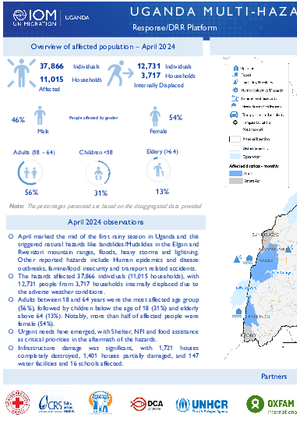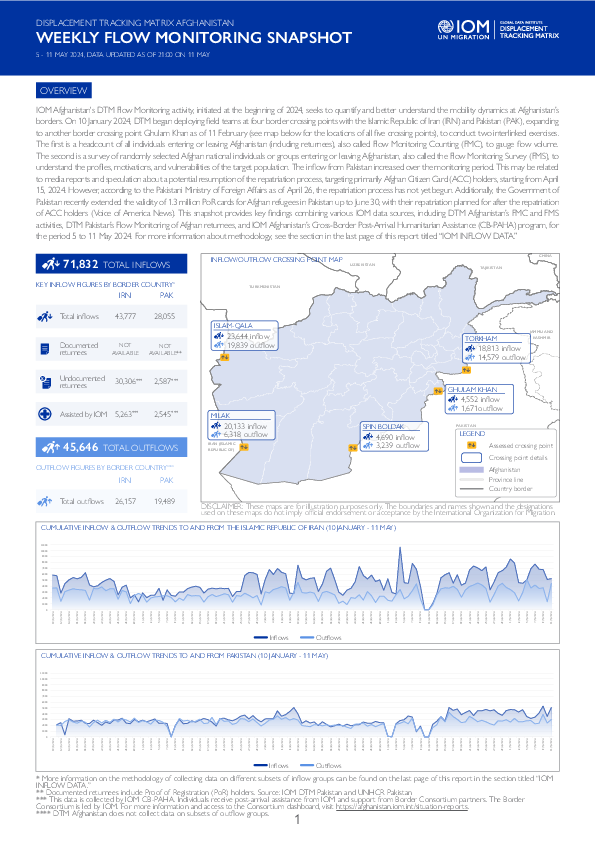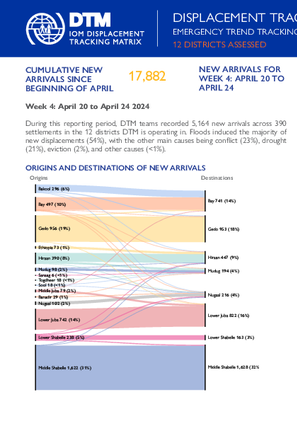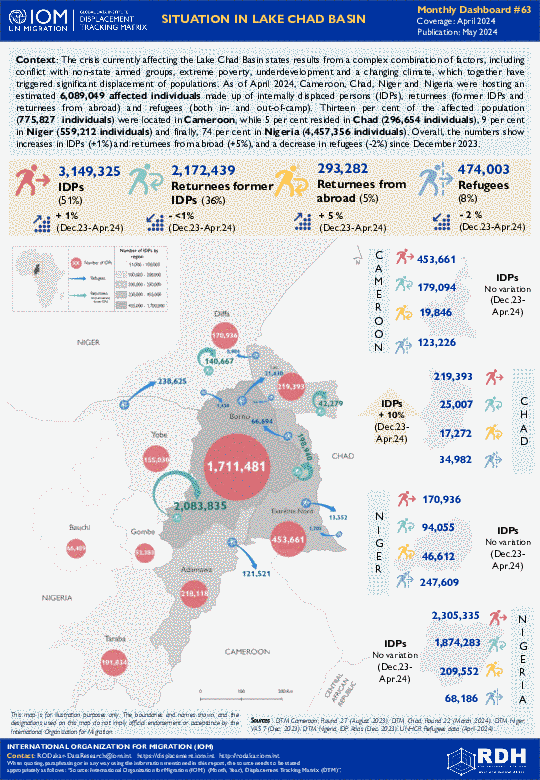-
Countries
-
Data and Analysis
-
Special Focus
-
Crisis Responses
Dashboard/Fact Sheet
Color
-

Contact
DTM Uganda, dtmuganda@iom.int
Language
English
Location
Uganda
Period Covered
Apr 01 2024
Apr 30 2024
Activity
- Mobility Tracking
- April marked the mid of the first rainy season in Uganda and this triggered natural hazards like landslides/Mudslides in the Elgon and Rwenzori mountain ranges, floods, heavy storms and lightning. Other reported hazards include Human epidemics and disease outbreaks, famine/food insecurity and transport related accidents.
- The hazards affected 37,866 individuals (11,015 households), with 12,731 people from 3,717 households internally displaced due to the adverse weather conditions.
- Adults between 18 and 64 years were the most affected age group (56%), followed by children below the age of 18 (31%) and elderly above 64 (13%). Notably, more than half of affected people were female (54%).
- Urgent needs have emerged, with Shelter, NFI and food assistance as critical priorities in the aftermath of the hazards.
- Infrastructure damage was significant, with 1,721 houses completely destroyed, 1,401 houses partially damaged, and 147
water facilities and 16 schools affected.

Contact
DTM Support — iomdrcdtm@iom.int
Language
French
Location
Democratic Republic of the Congo
Period Covered
May 04 2024
May 11 2024
Activity
- Mobility Tracking
- Event Tracking
Depuis le début de l’année 2024, la partie côtière du territoire de Fizi a été touchée par des inondations causées par la montée des eaux du lac Tanganyika et le débordement des rivières Mutambala et Luke, entraînant le déplacement de nombreuses personnes. La situation s’est aggravée au début du mois d’avril en raison de fortes pluies, provoquant des inondations qui ont affecté plusieurs villages du groupement de Basimukinji dans le territoire de Fizi. Ces événements ont engendré d’importantes destructions matérielles, des pertes considérables et ont malheureusement entraîné des décès signalés. En conséquence, environ 4 038 ménages et 25 383 individus ont été contraints de chercher refuge dans les villages d’accueil de Baraka et Mwangaza du groupement Basimukinji, ainsi que dans ceux de Mboko et Makobola du groupement de Babungwe Nord.
La situation a provoqué d’importantes perturbations sur la Route Nationale N°5 (axe Kikongo – Makobola), entraînant une forte congestion du trafic routier. De plus, elle a eu un impact significatif sur la sécurité alimentaire des zones d’accueil, avec environ 12 pour cent des terres agricoles de la région touchées par les inondations. Les voies d’approvisionnement vers les grandes agglomérations comme Bukavu et Uvira sont de plus en plus perturbées, engendrant ainsi une pénurie alimentaire dans ces régions.

Contact
DTMAfghanistan@iom.int
Language
English
Location
Afghanistan
Period Covered
May 05 2024
May 11 2024
Activity
- Survey
- Flow Monitoring Survey
- Flow Monitoring
IOM Afghanistan's DTM Flow Monitoring activity, initiated at the beginning of 2024, seeks to quantify and better understand the mobility dynamics at Afghanistan’s borders. On 10 January 2024, DTM began deploying field teams at four border crossing points with the Islamic Republic of Iran (IRN) and Pakistan (PAK), expanding to another border crossing point Ghulam Khan as of 11 February (see map below for the locations of all five crossing points), to conduct two interlinked exercises. The first is a headcount of all individuals entering or leaving Afghanistan (including returnees), also called Flow Monitoring Counting (FMC), to gauge flow volume. The second is a survey of randomly selected Afghan national individuals or groups entering or leaving Afghanistan, also called the Flow Monitoring Survey (FMS), to understand the profiles, motivations, and vulnerabilities of the target population. The inflow from Pakistan increased over the monitoring period. This may be related to media reports and speculation about a potential resumption of the repatriation process, targeting primarily Afghan Citizen Card (ACC) holders, starting from April 15, 2024. However, according to the Pakistani Ministry of Foreign Affairs as of April 26, the repatriation process has not yet begun. Additionally, the Government of Pakistan recently extended the validity of 1.3 million PoR cards for Afghan refugees in Pakistan up to June 30, with their repatriation planned for after the repatriation of ACC holders (Voice of America News). This snapshot provides key findings combining various IOM data sources, including DTM Afghanistan’s FMC and FMS activities, DTM Pakistan’s Flow Monitoring of Afghan returnees, and IOM Afghanistan’s Cross-Border Post-Arrival Humanitarian Assistance (CB-PAHA) program, for the period 5 to 11 May 2024. For more information about methodology, see the section in the last page of this report titled “IOM INFLOW DATA.”

Contact
DTM Somalia, IOMSomaliaDTM@iom.int
Language
English
Location
Somalia
Period Covered
Apr 20 2024
Apr 24 2024
Activity
- Mobility Tracking
- Baseline Assessment
This latest round of Emergency Trends Tracking was initiated in April 2024 to monitor displacements movements during the Gu rainy season. Districts covered in this round include Afgooye, Afmadow, Baardheere, Baidoa, Balcad, Belet Weyne, Gaalkacyo, Garoowe, Jamaame, Jowhar, Kismaayo, and Luuq.
ETT is a crisis-based tool that tracks sudden displacement triggered by specific events or emerging crises. The objective of ETT is to help prioritize humanitarian response and to enable partners to deliver rapid assistance. Based on previous shock induced displacement patterns, the humanitarian community expects that people will continue to move toward urban areas in search of humanitarian services. Consequently, the ETT coverage focuses on the main urban centers and surrounding villages for each assessed district. The data is collected through Key Informant Interviews (KIIs) at the location level, from Sunday to Wednesday every week. It includes information on new arrivals, numbers and demographic of IDPs, reasons for displacement, intentions, humanitarian assistance and priority needs among others.

Contact
DTM Nigeria, iomnigeriadtm@iom.int
Language
English
Location
Nigeria
Period Covered
Mar 01 2024
Mar 31 2024
Activity
- Flow Monitoring
This report presents the data for the month of March 2024, collected through direct interviews and direct observation by DTM enumerators and triangulated via a network of key informants. It highlights the number of herders and their herds identified at 16 counting points. Notably, this enumeration included areas within the Kachia, Kaura, Kaita, and Faskari Local Government Areas (LGAs) of Kaduna and Katsina states, under the auspices of the Peacebuilding Fund. Additionally, it extended to Batsari, Jibia, Kankara, and Dan Musa LGAs of Katsina state, which
were supported by the European Union Fund.
In March 2024, Transhumance Flow Monitoring tool identified 1,322 herders in Kaduna State and 197 herders in Katsina State. The animal count was estimated at 43,772 for Kaduna State and 5,013 for Katsina State. Notably, 97 per cent of the total number of herders departed from states within Nigeria, while the remaining 3 per cent departed from Niger.

Contact
DTM Nigeria, iomnigeriadtm@iom.int
Language
English
Location
Nigeria
Period Covered
Feb 01 2024
Feb 29 2024
Activity
- Flow Monitoring
This report presents the data for the month of February 2024, collected through direct interviews and direct observation by DTM enumerators and triangulated via a network of key informants. It highlights the number of herders and their herds identified at 34 counting points. Notably, this enumeration included areas within the Kachia, Kaura, Kaita, and Faskari Local Government Areas (LGAs) of Kaduna and Katsina states, under the auspices of the Peacebuilding Fund. Additionally, it extended to Batsari, Jibia, Kankara, and Dan Musa LGAs of Katsina State, which were supported by the European Union Fund.
In February 2024, Transhumance Flow Monitoring tool identified 1,423 herders in Kaduna State and 600 herders in Katsina State. The animal count was estimated at 55,211 for Kaduna State and 13,684 for Katsina State. Notably, 91 per cent of the total number of herders departed from states within Nigeria, while the remaining 9 per cent departed from Niger.
The Central Sahel area, and in particular the Liptako Gourma region, which borders Burkina Faso, Mali and Niger, is affected by a complex crisis involving growing competition over dwindling resources; climatic variability; demographic pressure; high levels of poverty; disaffection and a lack of livelihood opportunities; communal tensions; the absence of state institutions and basic services; and violence related to organized crime and non-state armed groups. The crisis has triggered significant displacement of populations in the concerned countries and is affecting neighbouring countries such as Mauritania and the coastal countries.
As of April 2024, 3,135,099 individuals have been displaced, including 2,636,880 internally displaced persons (84% of the displaced population) and 498,219 refugees (16% of the displaced population). Sixty-seven per cent of the displaced populations (2,100,990 individuals) were located in Burkina Faso, while 14 per cent resided in Mali (442,363 individuals), 11 per cent in Niger (352,553 individuals) and 4 per cent in Mauritania (119,354 individuals). The crisis’ recent spill over to coastal countries, namely Côte d’Ivoire, Ghana, Togo and Benin, shows growing number of refugees coming from the Central Sahel and populations internally displaced. As of April, 119,839 individuals were affected by displacement within the four countries (18,897 in Benin, 47,392 in Côte d’Ivoire, 7,238 in Ghana and 46,312 in Togo) of which 30,372 were internally displaced.
La région du Sahel central, et plus particulièrement la zone du Liptako Gourma, qui enjambe le Burkina Faso, le Mali et le Niger, est témoin d’une crise complexe qui comprend comme enjeux une compétition grandissante pour le contrôle des ressources; des bouleversements climatiques; une croissance démographique galopante; des niveaux élevés de pauvreté; l’absence d’opportunités économiques; des tensions communautaires; l’absence de présence étatique et le manque de services sociaux de base; ainsi que des violences provoquées par des réseaux de crime organisé et des groupes armés non-étatiques. La crise a engendré des déplacements importants de populations dans les pays concernés et affecte, par ailleurs, des pays voisins tels que la Mauritanie ou les pays côtiers.
En avril 2024, 3 135 099 individus sont déplacés, y compris 2 636 880 personnes déplacées internes (84% de la population affectée) et 498 219 réfugiés (16% de la population affectée). Soixante-sept pour cent des individus (2 100 990 personnes) se situaient au Burkina Faso, 14 pour cent résidaient au Mali (442 363 personnes), 11 pour cent au Niger (352 553 personnes) et 4 pour cent en Mauritanie (119 354 personnes). Le recent déversement de cette crise vers les pays côtiers, à savoir la Côte d’Ivoire, le Ghana, le Togo et le Bénin, fait prevue d’un nombre croissant de réfugiés arrivant du Sahel central vers ces pays et, à l’interne, des populations déplacées. En avril, sont recensés 119 839 individus affectés dans ces quatre pays réunis (18 897 au Bénin, 47 392 en Côte d’Ivoire, 7 238 au Ghana et 46 312 au Togo) dont un total de 30 372 déplacés internes.
The Central African Republic (CAR), which has experienced continuous volatility for the past two decades, has been riddled by a crisis which ignited in 2012 with a violent takeover of power and has developed into a complex protracted state of permanent insecurity and fragility which has spilled over into neighbouring countries. The crisis is characterized by power struggles amongst elites, the absence of state institutions and public investment, religious and ethnic tensions and disputes for the control of key resources. Moreover, the crisis in Sudan, which started in April 2023, is affecting the eastern part of the CAR witnessing arrivals of displaced populations. As of April 2024, 4,033,831 individuals were affected, including 521,857 internally displaced persons (13% of the displaced population), 2,196,858 returnees former IDPs (54%), 528,521 returnees from abroad (13%) and 786,595 refugees (20%). In the CAR, the largest displaced population consists of former IDP returnees. Refugees from the CAR are primarily hosted by Cameroon (353,153 individuals, or 47% of the refugees), the Democratic Republic of the Congo (DRC) (212,437 individuals, or 28% of the refugees) and Chad (134,184 individuals, or 18% of the refugees). Nonetheless, 15,150 refugees from the Central African Republic are still living in Sudan (2% of the refugees). Since the beginning of the Sudan crisis, a total of 41,795 individuals have entered the CAR. Indeed, the country is home for refugees from neighbouring countries, hosting a total of 35,197 refugees coming from Sudan (24,466 individuals), the DRC (6,440 individuals), South Soudan (2,792 individuals) and Chad (1,499 individuals).
The crisis currently affecting the Lake Chad Basin states results from a complex combination of factors, including conflict with non-state armed groups, extreme poverty, underdevelopment and a changing climate, which together have triggered significant displacement of populations. As of April 2024, Cameroon, Chad, Niger and Nigeria were hosting an estimated 6,089,049 affected individuals made up of internally displaced persons (IDPs), returnees (former IDPs and returnees from abroad) and refugees (both in- and out-of-camp). Thirteen per cent of the affected population (775,827 individuals) were located in Cameroon, while 5 per cent resided in Chad (296,654 individuals), 9 per cent in Niger (559,212 individuals) and finally, 74 per cent in Nigeria (4,457,356 individuals). Overall, the numbers show increases in IDPs (+1%) and returnees from abroad (+5%), and a decrease in refugees (-2%) since December 2023.
Pagination
- Previous page
- Page 11
- Next page



